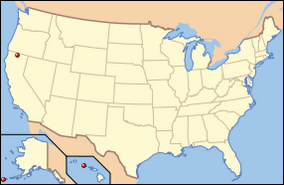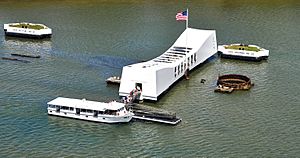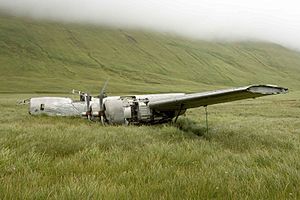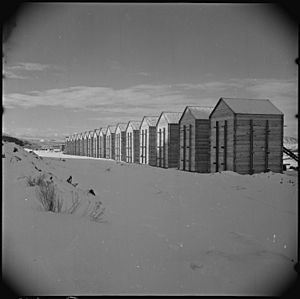World War II Valor in the Pacific National Monument facts for kids
Quick facts for kids World War II Valor in the Pacific National Monument |
|
|---|---|
 |
|
| Location | Alaska, California & Hawaii, USA |
| Area | 6,310 acres (25.5 km2) |
| Created | December 5, 2008 |
| Visitors | 1,574,156 (in 2015) |
| Governing body | National Park Service & Fish and Wildlife Service |
| Website | World War II Valor in the Pacific National Monument |
The World War II Valor in the Pacific National Monument was a special place in the United States that remembered important events, people, and locations from World War II in the Pacific Ocean. It was a U.S. National Monument.
This monument was created to honor the bravery and sacrifices made during the war. However, on March 12, 2019, a new law changed things. The monument was divided into three new national memorials. These are the Pearl Harbor National Memorial, the Aleutian Islands World War II National Monument, and the Tule Lake National Monument.
Contents
Remembering World War II Sites
The World War II Valor in the Pacific National Monument included nine important sites. These sites were spread across three different U.S. states. Together, they covered about 6,310 acres (about 25.5 square kilometers).
Hawaii's Historic Sites
In Hawaii, the National Park Service looked after several key locations. These sites are all found at Pearl Harbor on the island of Oahu. Pearl Harbor is famous for a surprise attack that happened there during World War II.
- The USS Arizona Memorial and its Visitor Center. This memorial floats above the sunken battleship USS Arizona.
- The USS Utah Memorial. This honors another battleship sunk during the attack.
- The USS Oklahoma Memorial. This remembers the crew of the USS Oklahoma.
- Six Chief Petty Officer Bungalows on Ford Island. These were homes for important Navy officers.
- Mooring Quays F6, F7, and F8. These were docks where battleships were tied up, forming part of Battleship Row.
Alaska's War Remnants
In Alaska, the Fish and Wildlife Service managed sites. These are part of the Alaska Maritime National Wildlife Refuge. They show the impact of the war in a very remote area.
- The Battle of Attu battlefield remnants on Attu Island, in the Aleutian Islands. This was the only land battle of World War II fought in North America.
- Sites related to the Japanese occupation of Kiska Island, also in the Aleutian Islands.
- The crash site of an Atka B-24D Liberator plane on Atka Island, Aleutian Islands.
California's Tule Lake Unit
In California, one special site was managed by both the National Park Service and the Fish and Wildlife Service.
- The Tule Lake Unit is in Modoc County, in northeastern California. This site was once an internment camp for Japanese Americans during World War II. It reminds us of a difficult time in U.S. history.
How the Monument Was Managed
The monument was looked after by two main groups. These were the National Park Service and the U.S. Fish and Wildlife Service. It's important to know that the actual sunken ships, like the Arizona, Utah, and Oklahoma, were not part of the monument itself. They remained under the control of the U.S. Navy.
When It Was Created
The monument was officially created on December 5, 2008. President George W. Bush used a special law called the Antiquities Act of 1906 to do this. The date was chosen to be close to the 67th anniversary of the Attack on Pearl Harbor, which happened on December 7, 1941.
This was the first time a national monument was created in Alaska since 1980. That year, the Alaska National Interest Lands Conservation Act (ANILCA) was passed.




